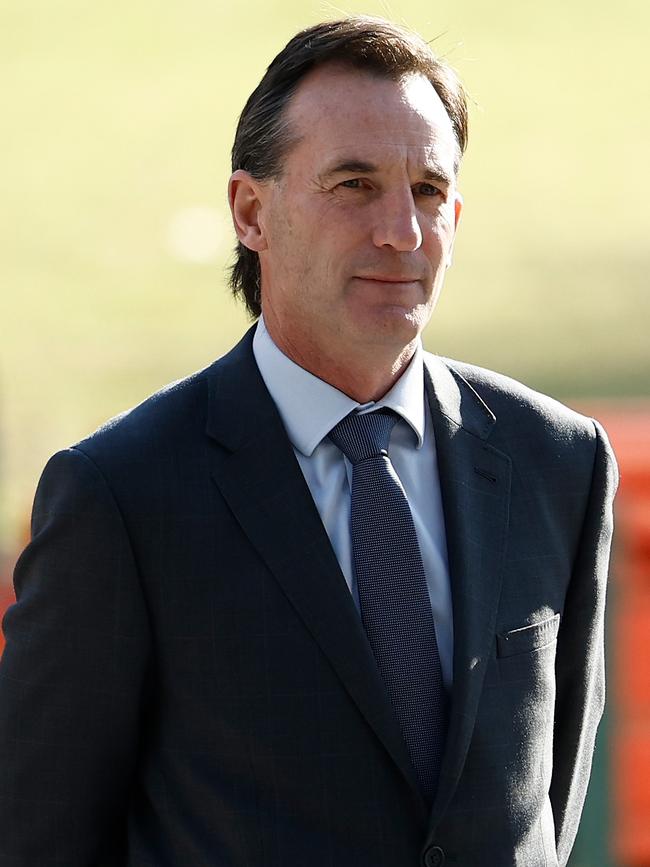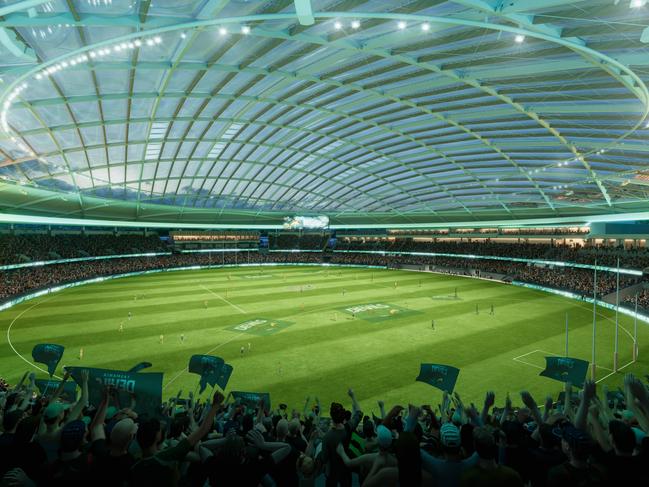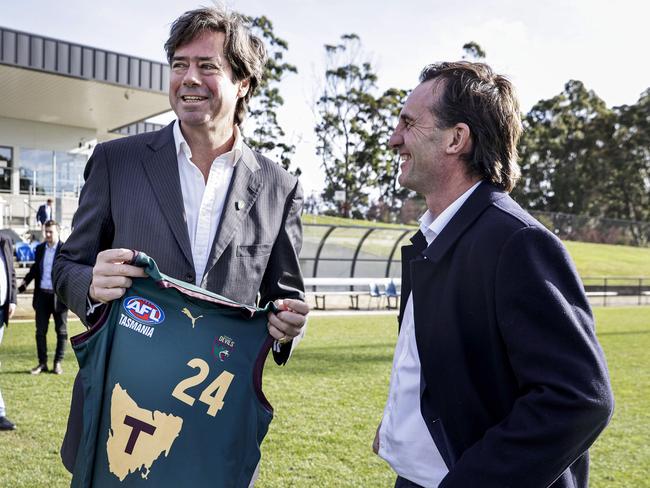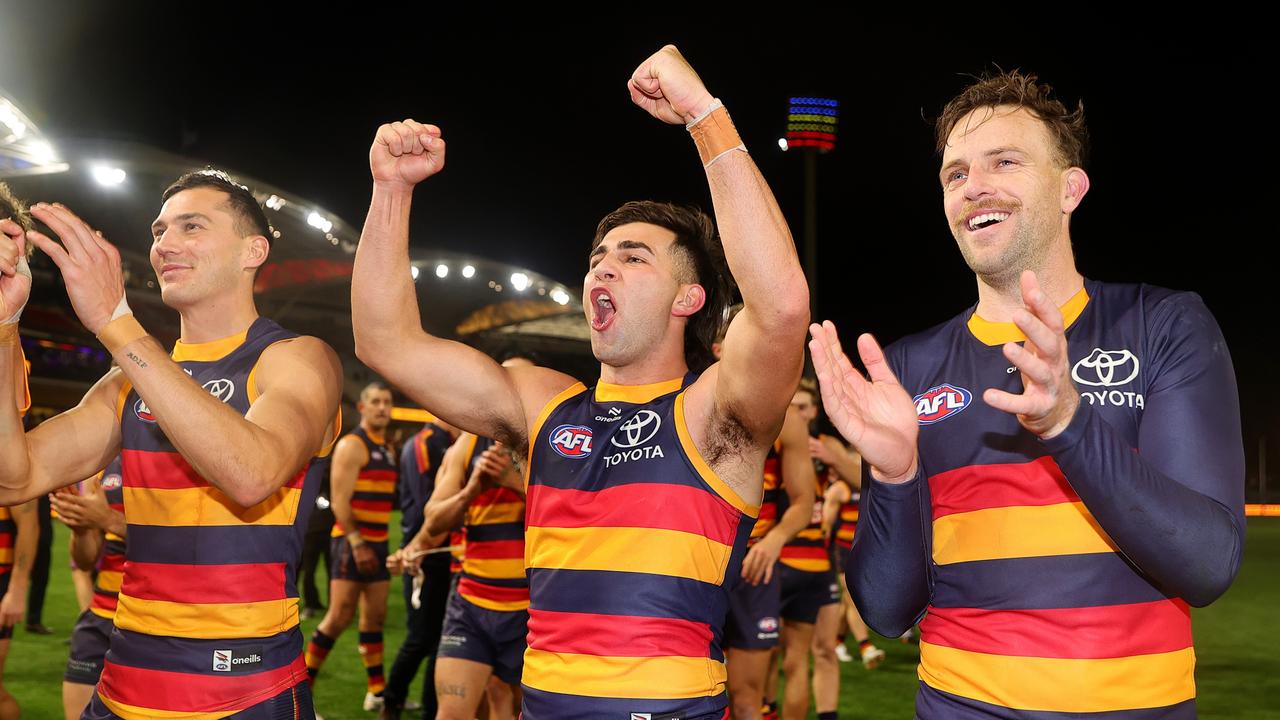The AFL’s ‘dodgy’ Tassie’s venture might be playing out precisely as it was designed – to fail
Sitting across from Andrew Dillon at AFL House in late January, Jacqui Lambie smelt a rat. Now, after a week of political turmoil, she’s not the only one questioning the league’s motive.

AFL
Don't miss out on the headlines from AFL. Followed categories will be added to My News.
Sitting across from Andrew Dillon in the boardroom at AFL House in the Docklands, Jacqui Lambie smelt a rat.
It was late January this year and the outspoken Tasmanian Senator had requested a meeting with the game’s top brass to better understand their thinking behind demands for a roofed stadium at Hobart’s Macquarie Point.
“I went to see Andrew Dillon after the publication of Dr Nicholas Gruen’s review on the business case for the AFL stadium,” Lambie said.
“Gruen’s report clearly shows that the stadium will be at least a billion dollars, and that there are significant issues with the business case.
“Dillon told me ‘that report is wrong’, (but) I had it with me, so I put it on the table and asked him to point out where the report was wrong – and he couldn’t.”


There’s a growing sense on the Apple Isle that the AFL’s bold Tasmanian venture is playing out precisely as it was designed. To fail.
Independent MP Andrew Wilkie, the man who blew the whistle on rampant illicit drug use in the game last year, believes the AFL may have deliberately pushed a deal that made it impossible for the state to get a team.
“Surely a modest additional investment in one or both of the two existing stadiums is all that’s needed – unless, of course, the AFL’s plan all along was actually to stop Tasmania getting a footy team by making the absurd demand of a white elephant stadium,” Wilkie said.
“The AFL is a bully.
“It would know that Tasmania doesn’t need, can’t afford and mostly doesn’t want a third AFL-standard ground.
“But the AFL doesn’t seem to care about that, preferring instead to put its self-interest ahead of the public interest, and in doing so calling into question its continuing tax-free status.
“It needs to read the room and offer to negotiate a new deal with the Tasmanian Government that wouldn’t require a new stadium.”

In a year of unrest at AFL House, the Tasmanian Devils dilemma inherited from his predecessor Gillon McLachlan shapes as Dillon’s biggest test.
“The AFL is pulling this state apart and they need to stop bullying Tasmania and renegotiate the deal for the AFL stadium,” Lambie said.
“No other state has had these conditions put on them. I warned him (Dillon at the January meeting) that the AFL’s behaviour over the stadium was hurting the AFL brand in Tasmania.
“Eddie McGuire told the ABC (on Wednesday) that the clubs would be relieved if the Tasmanian deal went down.
“I wonder if the AFL clubs ever wanted Tassie to have a team. If the AFL was actually a national sporting organisation we would have had a team years ago.
“Tasmania already has one of the best grounds in the country at York Park in Launceston and $130 million is being spent on an upgrade.
“All of the pressure at the moment is on the state government – but the pressure should be on the AFL to renegotiate what was a dodgy deal in the first place.”

A builder for the proposed $1 billion Macquarie Point stadium is yet to be appointed, putting the project at risk of breaching a condition for at least half to be built by October 2027.
The ultimate say on whether the Devils get off the ground will sit with the 18 rival clubs, who have the power of veto over the AFL’s 19th licence if the stadium cannot meet the deadline.
Sydney chairman Andrew Pridham, who questioned the true cost of a roofed-stadium during the bid process revealed on Friday that he would be open to some flexibility on the deal.
“The initial cost analysis always seemed light to me,” Pridham said.
“That was my complaint at the time. It was done with a bit too much emotion. A Tasmanian team would be fantastic but emotion should not override objective financial modelling.
“Clearly the stadium will cost more than initially forecast, but I think it will be worth the investment.
“I am only one voice, but I would be prepared to compromise, but it wouldn’t be on the stadium, it would be on timing. Timing to respect the impact of the political process on the club’s formation.
“But what I wouldn’t compromise on is saying, ‘OK, bring the team in and we will talk about the stadium later’.”

Legendary Launceston-born sports broadcaster Tim Lane, a long-time champion of a Tasmanian team, said it was “ironic and perhaps perverse” that the clubs would have the final say given the AFL Commission had been formed in the early 1980s with the intention of taking away their “reflexive default to self-interest”.
“Although the clubs ultimately have a power of veto, I don’t know that the AFL has ever failed to persuade them on an issue it considers of fundamental importance to the national development of the game. Gold Coast and GWS come to mind,” Lane said.
“Now what that tells us in relation to Tasmania, I’m not sure - but I don’t like it.”
Lane said the critical question that had not been answered was why there needed to be a roof on the stadium at all.
“I reckon that question can’t be asked often enough - because as people of fair mind are pointing out, Hobart has a lower annual rainfall than Melbourne, much lower than Sydney where games are played out in the elements.
“And yet Tasmania is being forced to pay for a roof on a stadium.
“I have said for years that this had to be managed in a way that actually brought Tasmanians together and didn’t divide them. Look where we are now.”
Lane also questioned the logic of building a non-retractable roof, preventing the playing of Test Match cricket at the ground.

Former Hawthorn president Jeff Kennett said the only solution was to scrap the Macquarie Point stadium and establish the team in Launceston.
“It would be an absolute tragedy and terribly demoralising to the whole community of Tasmania if in fact a team did not take to the field,” Kennett said.
“Launceston is already one of the best grounds that the AFL play on around the country, the government is already spending money there and if they can lock in the federal government’s money, which is $240 million, they can increase the seating capacity to the 23,000 that they want.
“They would be able to have a highly-competitive ground at half the cost of what is now being proposed.
“I would ask the AFL to be flexible - they’ve lifted everyone’s hopes and aspirations, but the cost of the proposed stadium is now well beyond that which Tasmania can afford, and so it’s up to the AFL to show leadership and flexibility and to think of an alternative.
“After all, they’ve only put in $15 million themselves to a stadium that is now going to cost over $1 billion.
“Hobart has Mona, it has the docks, Salamanca Place and the Sydney-to-Hobart - and what we have shown with Hawthorn at Launceston is that supporters go there for a match and then travel south, either via the east or west coast.
“It would be great for the whole state. And you don’t need a roof in Launceston. There’s only one other stadium in the AFL that has a roof (Marvel Stadium) - and it is easily the worst ground in the country, so why insist on that?”
Originally published as The AFL’s ‘dodgy’ Tassie’s venture might be playing out precisely as it was designed – to fail



